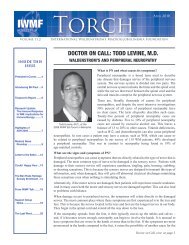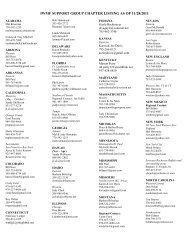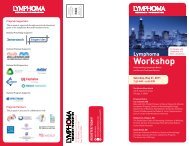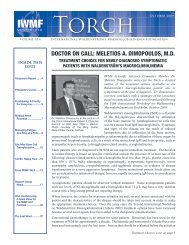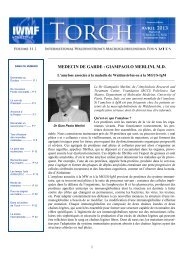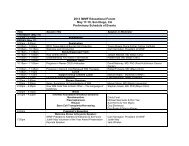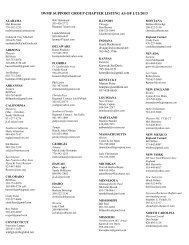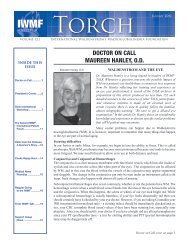Fall 2007 - International Waldenstrom's Macroglobulinemia ...
Fall 2007 - International Waldenstrom's Macroglobulinemia ...
Fall 2007 - International Waldenstrom's Macroglobulinemia ...
You also want an ePaper? Increase the reach of your titles
YUMPU automatically turns print PDFs into web optimized ePapers that Google loves.
Non Profit Org<br />
US Postage<br />
PAID<br />
Manasota, FL<br />
Permit No. 133<br />
<strong>International</strong> Waldenstrom’s<br />
<strong>Macroglobulinemia</strong> Foundation<br />
3932D Swift Road<br />
Sarasota, FL 34231-6541<br />
Telephone 941-927-4963 • Fax 941-927-4467<br />
E-mail: info@iwmf.com. • www.iwmf.com<br />
IWMF is a 501(c)(3) tax exempt non-profit organization<br />
Fed ID #54-1784426<br />
PAGE 20<br />
What is, cont from page 3<br />
picked up by the detectors and provides information about the cell’s characteristics.<br />
Light that bounces forward (called forward scatter or FSC) gives information about the cell size. Light that bounces off the<br />
side (called side scatter or SSC) provides information about the inner structure of the cell, such as the shape of its nucleus<br />
or the amount and kind of granules present. Each type of cell in the immune system (lymphocytes, monocytes, neutrophils,<br />
etc.) has a unique combination of forward and side scatter measurements, allowing the instrument to count the number of<br />
each type of cell present in the sample.<br />
Flow cytometers can also use antibodies tagged with fluorochrome stains that bind to specific antigens on the cell surfaces.<br />
In the case of leukemias and lymphomas, these fluorochrome-tagged antibodies bind with and identify protein surface<br />
markers on the immune cells called cluster differentiation (CD) markers. When a fluorochrome stain is added to the cell<br />
sample, a laser beam excites the cells so that they fluoresce and emit a specific color of light, depending on the type of<br />
fluorochrome stain used. Color detectors collect the different colors of light and send the data to the computer.<br />
Modern flow cytometers usually have multiple lasers and fluorescence detectors. Increasing the numbers of lasers and<br />
detectors allows for multiple antibody labeling and can more precisely identify a target population of cells.<br />
The computer attached to the flow cytometer tabulates the data from the light scatter measurements and the fluorescing cells<br />
and can plot the data in several ways. The most common plot is a graph called a histogram, where fluorescence intensity<br />
or the degree of scattered light (x-axis) is plotted against the frequency at which this type of event occurs (y-axis). From<br />
such a histogram, the population distribution for the particular cell(s) of interest can be determined. Other types of plots are<br />
called dot, density, or contour plots. The operator of the flow cytometer can select certain cell populations based on their<br />
characteristics in order to refine and further analyze the data—a process called gating.<br />
Flow cytometers can also be configured as sorting instruments. As the cells pass through, they can be electrically charged<br />
selectively and on their exit can be deflected into separate paths of flow. It is therefore possible to separate several defined<br />
populations of cells from an original mixed sample with a high degree of accuracy and speed. Sorted cells can be further<br />
examined microscopically, re-stained for additional analysis, or put into tissue culture for research purposes.





